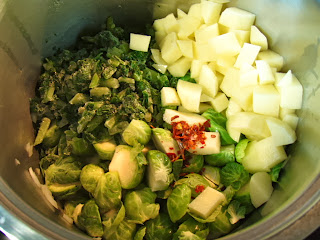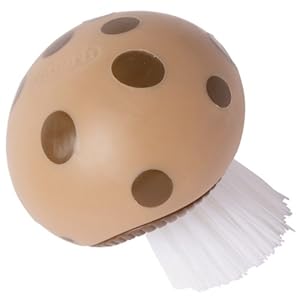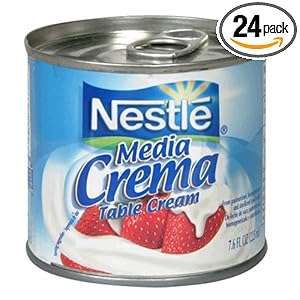Today's post is about a cute student's desk that we got for my DH's music room. I have begun to collect French provincial furniture pieces and I am super stoked about the way the all look! ^__^
So far I have only dealt with regular paint jobs, mostly out of laziness, but I wanted this piece to be something special for my special man. So I engaged him in a lenghty conversation regarding both color and finishes. After much deliberation, DH went for a blue-green and a distressed look. This tutorial goes through all the steps I took to achieve the final look. I began with a CL student desk. Great bones, but rough to look at.
My first order of business, was to remove all the hardware. I knew at fist glance that this was not the original hardware, but I was not worried. Hardware it's fairly easy to find on Ebay or Etsy. However, to my great dismay, I realized that the previous owner (in order to fit those 'new' handles) had drilled a new set of holes on the drawers. The random things people do, always amazes me. LOL
So what was a gal to do? Well, I could have left them in place (the period hardware would easily cover the secondary holes) or I could fix the problem. I opted for option #2 as I am somewhat of a stickler in that regard. LOL. I got some wood filler out and proceeded to stick as much as I could inside the drilled abominations.
There is no need to be precise with wood filler...I just basically smeared the stuff on and pushed it in, as much as I could, in the crevices I wanted to patch.
I waited a full 24 hrs before I sanded the whole thing smooth. I also removed with a knife any filler that had made its way into my rightful holes. "Look ma, no holes, no holes!"
While the wood filler was drying I started working on the main body of the desk. Since the top is made of formica I made sure I sanded it, and roughed it up, quite a bit.
I then wiped the whole desk and drawers down with a TSP solution. I waited for it all to be dry and then proceeded to prime the entire piece with a spray bonding primer (Zinsser).
24 hrs later, I sanded the whole desk top down for extra smoothness - as well as all areas that had gotten too thick with primer. For the top coat, I wanted to try something new. I really like oil based paint for its thick and durable finish. But that would not have been appropriate for a distressed piece. I did not want to use latex paint, as I hate the finish, so I opted for a water based interior satin enamel from Behr in "Awning".
Here is the desk with two coats of enamel...
...I waited a full 48 hours before I begin to distress the piece using a mix of 100 and 220 grit sandpaper. I began with the drawers as they are a smaller area and would be a good testing piece...
...and then I proceeded to distress/sand the rest of the piece. I made sure to be heavier on some areas and lighter on other. I didn't want to achieve a consistent look since wear is always random. I focused on the high points of the piece, where wear would occur naturally and, in some areas, sanded all the way through the primer and into the wood. Once I was happy with the results I stopped and wiped the whole thing down with a dry lint free rag.
Since the color was so bright I decided to tone it down with a glaze. I used a mix of 3 parts clear Martha Stewart faux finishing glaze to 1 part Martha Stewart metallic glaze in "Black Coffee".
I mixed the glazing medium together in a plastic cup and then, with a disposable brush, I began to apply it. I went with the grain of the wood, for the most part, but it was a relaxed application indeed.
I waited a few seconds and then I begin wiping the excess glaze off with a dry paper towel.
I then followed with a damp paper towel to achieve the desired look. Some people like heavy glazing and some people like light glazing. I favor lighter glazing, so I kept on wiping until I saw what I liked.
I repeated the process through the entire piece working only on a small area at the time. The glaze remains 'open' and workable/wipeable only for a certain amount of time. After that, the glaze is set and won't be removable any longer. So I worked on smaller areas to have full control.
At this point I spray painted my hardware with my usual Rustoleum 'Rubbed Bronze'. I like to mount the handles on the back of a cardboard box for easy spraying/transporting.
...literally waiting for paint to dry! ^__^
I waited a full 48 hours for all my paint to fully cure and to make sure all was good and dry (it's been raining constantly here lately) before I applied a thin coat of furnishing wax. To apply an even coat, I put a dollop of wax into a piece of cheese cloth like so...
...and rubbed it on the pieces, with my fingers, using slight pressure. With hindsight, I should have worn gloves, as the wax melted on my fingers and I am pretty sure it's not a good for the skin -__-
After 15 minutes or so I polished the wax with a soft lint free cloth.
The wax goes on a bit hazy and gets hazier as it dries, but it does buff out very nicely. Here is a polished drawer on the right and an unpolished one on the left.
At this point, all that was left was to vacuum the inside of desk and drawers and wipe them down to get ready for papering. I will skip instructions on this step since I have plenty of posts
here and
here that describe the process in detail. Once I got all the drawers lined, I installed the hardware. That's really when the piece comes together for me. Hardware for a furniture piece is just like jewels on an outfit!
So here is the final result. Sitting pretty under DH guitars collection.
Here are a few shots of details that shows the finish up close...
...and a view of the lined drawers. I love this paper! It's so oldie but goodie. It's a Dollar Tree Store find and I keep going back for more ;)
Here you can clearly see all the layers: glaze, paint, primer, some original gold paint and finally wood.
Here is a view of the small drawer. I Like how the sanding accentuated the serpentine shapes here.
And finally here is a lateral shot. I was unsure of the big distressing on the upper corner of the side panel, but after I glazed it, it all made sense. I think it turned out pretty interesting. Now let's hope DH likes it or I'll have a new painting project on my hands.
Thank you for reading and I hope you enjoyed this tutorial.













































































